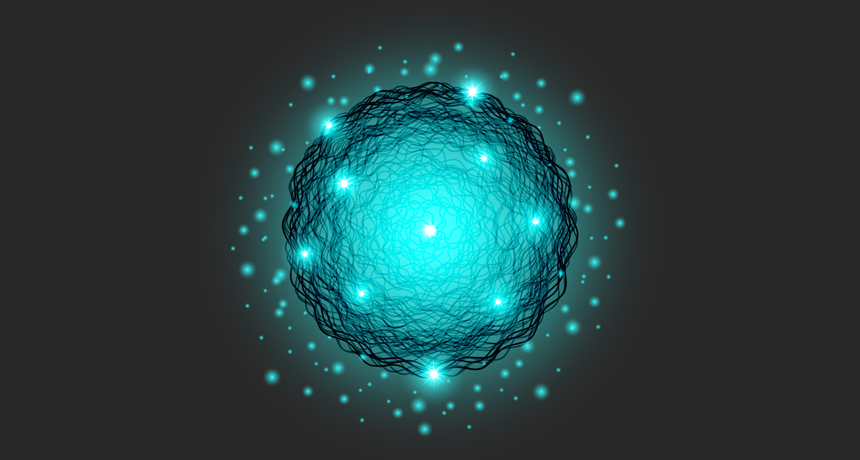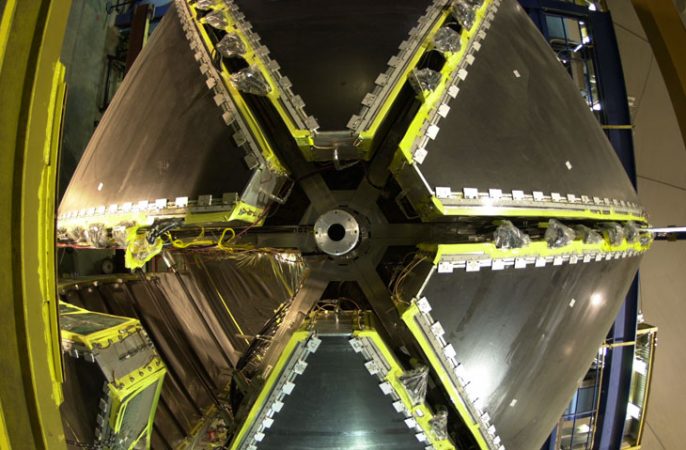To witness maximum pressure, peek inside a proton
New data suggest nothing else in the universe matches the pressures inside this particle

A proton (depicted in this artist’s illustration) is way too small to see. But that hasn’t stopped physicists from exploring the properties of these subatomic particles.
UASUMY/ISTOCKPHOTO
Pity the proton: These little particles are under a lot of pressure. Their innards are squeezed harder than any other substance known, new data show. Within these subatomic particles, lots of force is concentrated over a very small area — a sphere whose radius is about a trillionth that of a poppy seed.
And how punishing is that pressure? Try a million trillion trillion times the strength of Earth’s atmospheric pressure.
“It’s really the highest pressure we have ever seen,” says Volker Burkert. He’s a physicist at the Thomas Jefferson National Accelerator Facility in Newport News, Va. He was part of a team that published the extreme number in the May 17 Nature.
Neutron stars used to hold the pressure record. These incredibly dense, dead stars can form when a massive star explodes, allowing its core to collapse. The process ends up squeezing a mass greater than the sun’s into a remnant the size of a city. But the proton? Its internal pressure is around 10 times that of a neutron star’s.
Scientists had predicted that such pressures might occur inside protons. The new number comes from the first experimental gauge of that pressure.
Physicist Peter Schweitzer works at the University of Connecticut in Storrs. A proton’s internal pressure, he says, is one of its fundamental properties. It is “as important as electric charge or mass,” he says. Yet until now, that pressure figure had remained unknown.
Gauging the force
Protons are made up of smaller particles. These include quarks, which are electrically charged. Protons also contain gluons. These particles transmit the strong nuclear force that holds protons together. From the center of this ball of particles, Burkert and his team now report, an intense pressure pushes outward. But this record-breaking outward force is kept in check by an inward pressure from the outer regions of the proton.
This pressure pattern parallels what happens in much larger objects, says Oleg Teryaev. He’s a physicist at the Joint Institute for Nuclear Research in Dubna, Russia. “In some sense,” he says, “it’s looking like a star.” Stars also have pressures that push outward in their centers. Counteracting those pressures is the inward pull of gravity.
Stars are held together by gravity. Protons, however, are a different beast. They are held together by what’s known as the strong force. So “it’s natural, but it’s not completely trivial” that stars and protons would have similarities pressure-wise, Teryaev says.
To quantify the proton’s squeeze, researchers used data that had been collected three years ago in a particle detector at the Thomas Jefferson lab. It’s known as CLAS (short for the Continuous Electron Beam Accelerator Facility Large Acceptance Spectrometer). Scientists there beamed electrons with an energy of 6 billion electron volts at liquid hydrogen. Why hydrogen? It’s a rich source of protons. (Each atom’s nucleus is a single proton.)
Story continues below image.

As electrons slammed into the protons, those electrons ricocheted away together with particles of light known as photons. The researchers focused on how the electrons had interacted with the protons’ quarks. (They ignored the gluons, because the energy of the electrons had not been high enough to fully probe them.) To make their pressure estimate, the researchers assumed that the gluons’ pressure contribution was the same as the quarks’. In fact, that’s what some physicists do suspect.
By watching what happened as electrons interacted with the protons’ constituents, Burkert’s team was able to tease out, for the first time, the proton’s pressure.
Future particle accelerators, such as the planned Electron-Ion Collider, should allow for gauging the gluons’ contribution, too. That could offer an even more precise estimate of the crushing pressure that all tiny protons endure.







